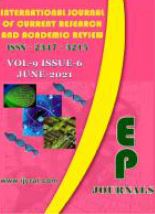Abstract Volume:9 Issue-6 Year-2021 Original Research Articles
 |
Online ISSN : 2347 - 3215 Issues : 12 per year Publisher : Excellent Publishers Email : editorijcret@gmail.com |
Stunting is the most challenging and prevalent public health problems particularly in low socioeconomic settings. The major aim of this study was to assess and compare factors associated with stunting among children aged 24-59 months in food secure and insecure households of Kuyu district, North Shewa Zone, central Oromia. A comparative, cross-sectional study was done on 618 children (309 children from food secure and 309 from insecure households) between February and March 2019. Multiple stages sampling method was performed to select children from each kebele. Anthropometric data were taken and nutritional statuses were generated using WHO Anthro v. 3.2.2. The data analysis was performed using SPSS version 20.0. Logistic regressions analysis was also carried out. The prevalence of stunting was 43.1% and 48.3%for children in food secure and insecure households, respectively. The multivariate analysis showed that low wealth status (AOR=7.44; 95% CI: 3.02, 18.46), a child who did not eat all food types (AOR=2.1; 95%CI:1.12, 4.24) and low dietary diversity (AOR=8.3; 95%CI:4.46, 15.5) were significantly linked with stunting in food-secure households. Whereas, in food, insecure households, poor dietary diversity(AOR=4.7; 95%CI:2.5, 8.83), low wealth status (AOR=2.5;95%CI:1.1, 5.55) and child who did not eat breakfast (AOR=2.04;95%CI:1.1, 3.78) were predictors for children stunting. The prevalence of stunting among children under five years old was very high in the study area. Therefore, ensuring food security status using the Productive Safety Net Program (PSNP) in harmony with the participation of all responsible bodies should be intensified to overcome the problem of under nutrition in the study area.
How to cite this article:
Tamiru Yazew. 2021. Factors Associated with Stunting among Children Aged 24-59 Months in Food Secure and Insecure Households of Kuyu District, Northern Oromia, Ethiopia: A Comparative Cross-Sectional Study.Int.J.Curr.Res.Aca.Rev. 9(6): 69-82doi: https://doi.org/10.20546/ijcrar.2021.906.008



Quick Navigation
- Print Article
- Full Text PDF
- How to Cite this Article
- on Google
- on Google Scholor
- Citation Alert By Google Scholar
